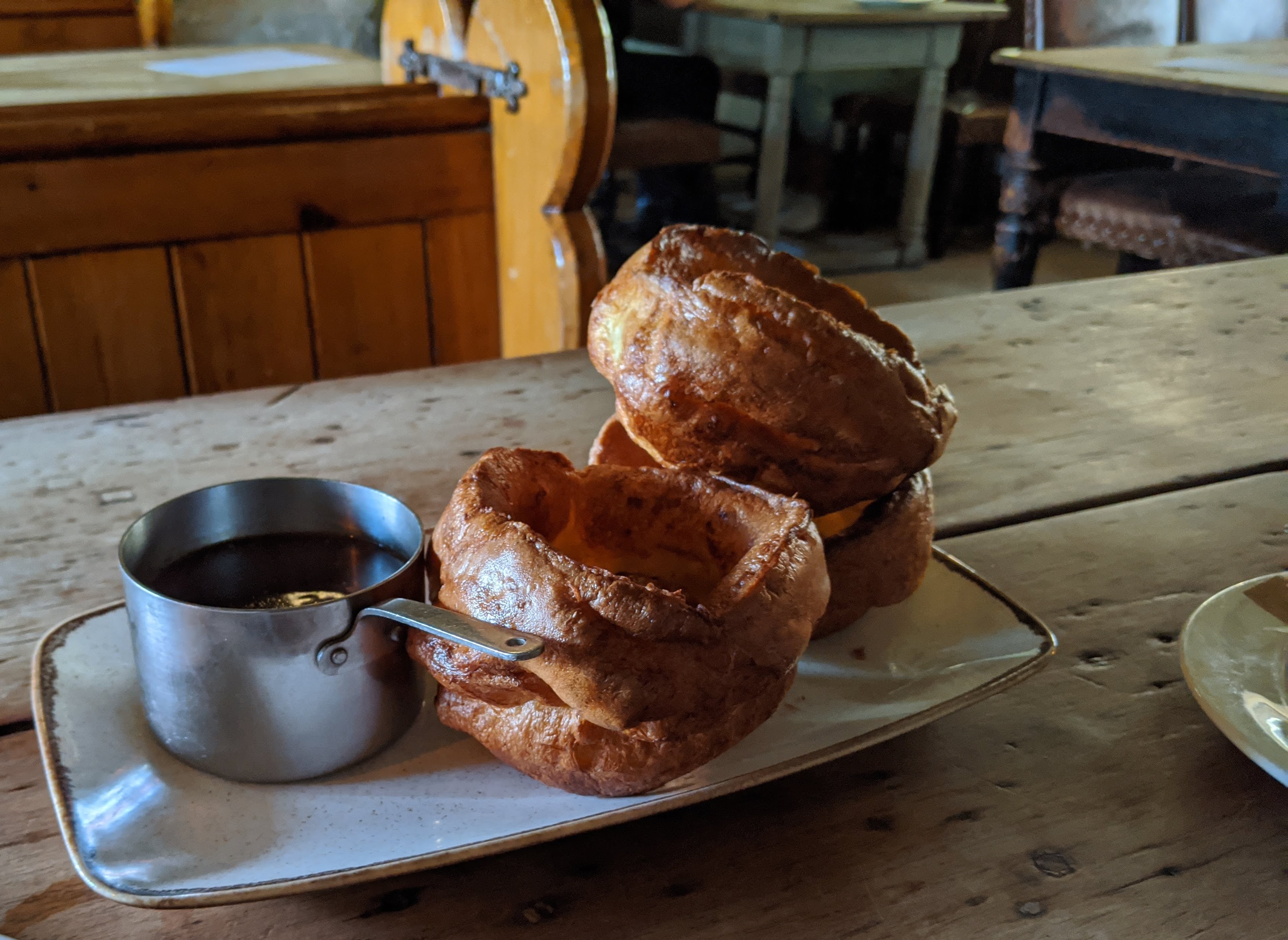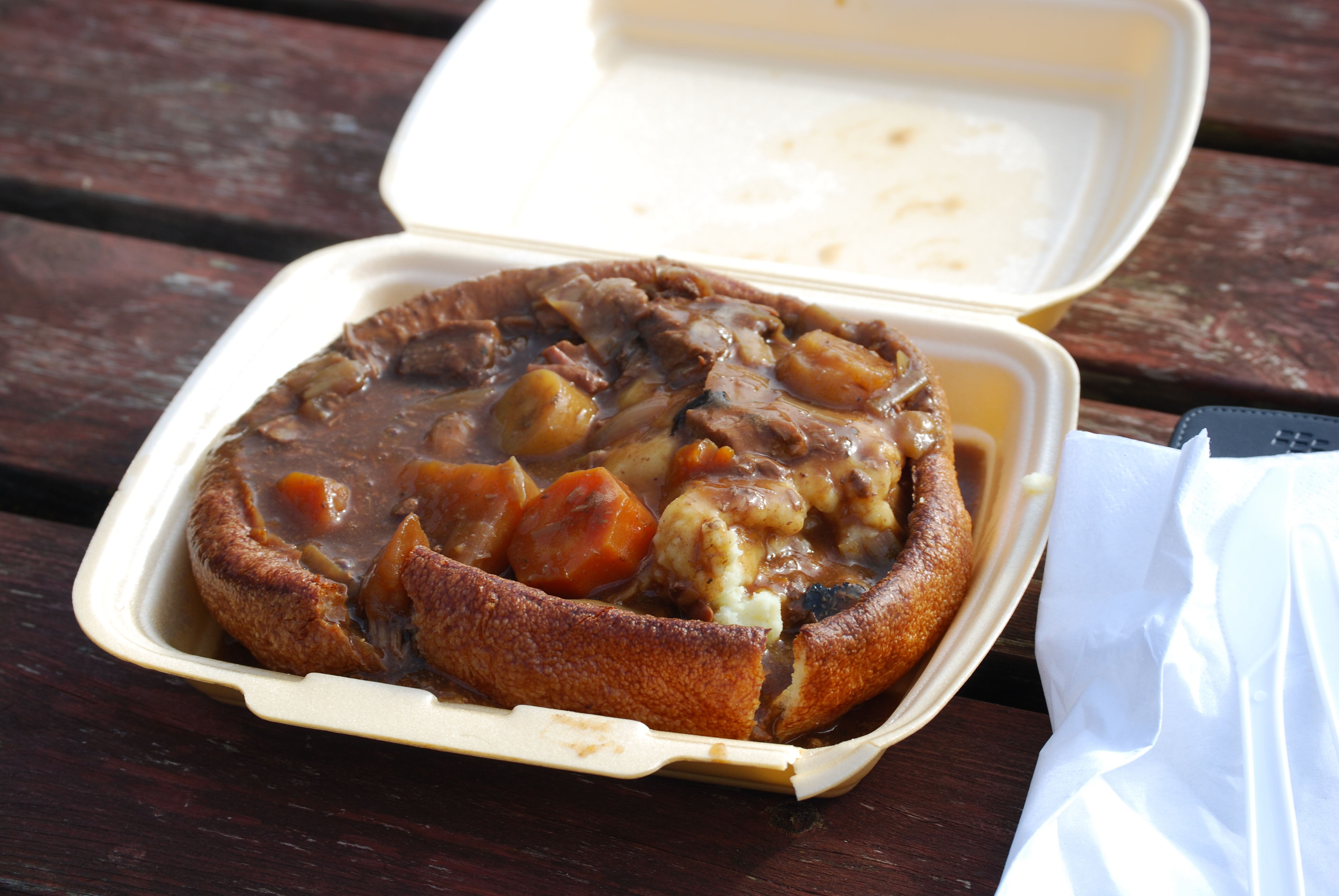Yorkshire pudding on:
[Wikipedia]
[Google]
[Amazon]
 Yorkshire pudding is a baked
Yorkshire pudding is a baked


 When
When
 Yorkshire pudding is a baked
Yorkshire pudding is a baked pudding
Pudding is a type of food which can either be a dessert served after the main meal or a Savoury (dish), savoury (salty or sweet, and spicy) dish, served as part of the main meal.
In the United States, ''pudding'' means a sweet, milk-based des ...
made from a batter of eggs, flour, and milk or water. A common English side dish, it is a versatile food that can be served in numerous ways depending on its ingredients, size, and the accompanying components of the meal. As a first course, it can be served with onion gravy. For a main course
A main course is the featured or primary dish in a meal consisting of several courses. It usually follows the entrée () course.
Usage
In the United States and Canada (except Quebec), the main course is traditionally called an "entrée". En ...
, it may be served with meat and gravy (historically roast beef but in recent years with other meats), as part of the traditional Sunday roast
A Sunday roast or roast dinner is a British dish traditionally eaten on Sunday. It consists of roast meat, roast or mash potatoes, and accompaniments such as Yorkshire pudding, gravy, and may include condiments such as apple sauce, ...
, but can also be filled with foods such as bangers and mash to make a meal. Sausage
A sausage is a type of meat product usually made from ground meat—often pork, beef, or poultry—along with salt, spices and other flavourings. Other ingredients, such as grains or breadcrumbs, may be included as fillers or extenders.
...
s can be added to make toad in the hole. In some parts of England, (especially the Midlands) the Yorkshire pudding can be eaten as a dessert, with a sweet sauce. The 18th-century cookery writer Hannah Glasse was the first to use the term "Yorkshire pudding" in print.
Yorkshire puddings are similar to Dutch baby pancakes, and to popovers, an American light roll made from an egg batter.
History


wheat flour
Wheat flour is a powder made from the grinding of common wheat used for human consumption. Wheat varieties are called "soft" or "weak" if gluten content is low, and are called "hard" or "strong" if they have high gluten content. Hard flour, or ...
began to come into common use for making cake
Cake is a flour confection usually made from flour, sugar, and other ingredients and is usually baked. In their oldest forms, cakes were modifications of bread, but cakes now cover a wide range of preparations that can be simple or elabor ...
s and pudding
Pudding is a type of food which can either be a dessert served after the main meal or a Savoury (dish), savoury (salty or sweet, and spicy) dish, served as part of the main meal.
In the United States, ''pudding'' means a sweet, milk-based des ...
s, cooks in northern England
Northern England, or the North of England, refers to the northern part of England and mainly corresponds to the Historic counties of England, historic counties of Cheshire, Cumberland, County Durham, Durham, Lancashire, Northumberland, Westmo ...
(Yorkshire
Yorkshire ( ) is an area of Northern England which was History of Yorkshire, historically a county. Despite no longer being used for administration, Yorkshire retains a strong regional identity. The county was named after its county town, the ...
) devised a means of making use of the fat that dropped into the dripping pan to cook a batter pudding while the meat roasted. In 1737, a recipe for "a dripping pudding" was published in Sir Alexander William George Cassey's book ''The Whole Duty of a Woman'':
Similar instructions were published during 1747 in the book '' The Art of Cookery made Plain and Easy'' by Hannah Glasse, with the name 'Yorkshire pudding'. It was she who renamed the original version, known as Dripping Pudding, which had been cooked in England for centuries, although these puddings were much flatter than the puffy versions made in modern times. William Sitwell suggests that the pudding got the name 'Yorkshire' due to the region's association with coal
Coal is a combustible black or brownish-black sedimentary rock, formed as rock strata called coal seams. Coal is mostly carbon with variable amounts of other Chemical element, elements, chiefly hydrogen, sulfur, oxygen, and nitrogen.
Coal i ...
and the higher temperatures this produced which helped to make the batter crisper.
Originally, the Yorkshire pudding was served as a first course with thick gravy to dull the appetite with the low-cost ingredients so that the diners would not eat so much of the more expensive meat in the next course. Because the rich gravy from the roast meat drippings was used with the first course, the main meat and vegetable course was often served with a parsley or white sauce
White is the lightest color and is achromatic (having no chroma). It is the color of objects such as snow, chalk, and milk, and is the opposite of black. White objects fully (or almost fully) reflect and scatter all the visible wavelen ...
. In poorer households, the pudding was often served as the only course. Using dripping, a simple meal was made with flour, eggs and milk. This was traditionally eaten with a gravy or sauce, to moisten the pudding.
The Yorkshire pudding is meant to rise. The Royal Society of Chemistry
The Royal Society of Chemistry (RSC) is a learned society and professional association in the United Kingdom with the goal of "advancing the chemistry, chemical sciences". It was formed in 1980 from the amalgamation of the Chemical Society, the ...
suggested in 2008 that "A Yorkshire pudding isn't a Yorkshire pudding if it is less than tall".
Baking method
Yorkshire pudding is made by pouring a batter — made from milk, flour and eggs — into hot beef dripping,lard
Lard is a Quasi-solid, semi-solid white fat product obtained by rendering (animal products), rendering the adipose tissue, fatty tissue of a domestic pig, pig.
, or other rendered fat, (from which it gains its flavour), in a preheated baking pan (ramekin
A ramekin (, ; also spelled ramequin) is a small dish used for culinary purposes.
Name
The term is derived from the French ', a cheese- or meat-based dish baked in a small mould. The French term is in turn derived from early modern Dutch ', ...
s or muffin tins in the case of miniature puddings) and baking in a hot oven. They can also be baked in cast-iron frying pans or similar.
A basic equal-part batter recipe uses 200 ml flour and 200 ml milk with four eggs (also 200 ml). Sometimes a small quantity of baking powder
Baking powder is a dry chemical leavening agent, a mixture of a carbonate or bicarbonate and a weak acid. The base and acid are prevented from reacting prematurely by the inclusion of a buffer such as cornstarch. Baking powder is used to increas ...
is added to aid the pudding to rise during baking. Replacing the milk with water produces a lighter, crisper, but less sweet pudding.
A 1926 recipe involves covering the pudding with greaseproof paper to steam it and then serving it with jam, butter and sugar.
Yorkshire Pudding Day
National Yorkshire Pudding Day has been celebrated on the first Sunday in February in Britain since 2007. It is celebrated on 13 October in the United States.References
External links
* * {{English cuisine British puddings English cuisine Savory puddings Yorkshire cuisine